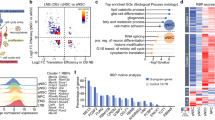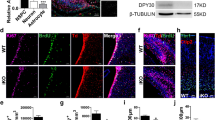Abstract
Fundamental questions remain unanswered about the transcriptional networks that control the identity and self-renewal of neural stem cells (NSCs), a specialized subset of astroglial cells that are endowed with stem properties and neurogenic capacity. Here we report that the zinc finger protein Ars2 (arsenite-resistance protein 2; also known as Srrt) is expressed by adult NSCs from the subventricular zone (SVZ) of mice, and that selective knockdown of Ars2 in cells expressing glial fibrillary acidic protein within the adult SVZ depletes the number of NSCs and their neurogenic capacity. These phenotypes are recapitulated in the postnatal SVZ of hGFAP-cre::Ars2fl/fl conditional knockout mice, but are more severe. Ex vivo assays show that Ars2 is necessary and sufficient to promote NSC self-renewal, and that it does so by positively regulating the expression of Sox2. Although plant1,2,3 and animal4,5 orthologues of Ars2 are known for their conserved roles in microRNA biogenesis, we unexpectedly observed that Ars2 retains its capacity to promote self-renewal in Drosha and Dicer1 knockout NSCs. Instead, chromatin immunoprecipitation revealed that Ars2 binds a specific region within the 6-kilobase NSC enhancer of Sox2. This association is RNA-independent, and the region that is bound is required for Ars2-mediated activation of Sox2. We used gel-shift analysis to refine the Sox2 region bound by Ars2 to a specific conserved DNA sequence. The importance of Sox2 as a critical downstream effector is shown by its ability to restore the self-renewal and multipotency defects of Ars2 knockout NSCs. Our findings reveal Ars2 as a new transcription factor that controls the multipotent progenitor state of NSCs through direct activation of the pluripotency factor Sox2.
This is a preview of subscription content, access via your institution
Access options
Subscribe to this journal
Receive 51 print issues and online access
$199.00 per year
only $3.90 per issue
Buy this article
- Purchase on Springer Link
- Instant access to full article PDF
Prices may be subject to local taxes which are calculated during checkout




Similar content being viewed by others
References
Laubinger, S. et al. Dual roles of the nuclear cap-binding complex and SERRATE in pre-mRNA splicing and microRNA processing in Arabidopsis thaliana. Proc. Natl Acad. Sci. USA 105, 8795–8800 (2008)
Lobbes, D., Rallapalli, G., Schmidt, D. D., Martin, C. & Clarke, J. SERRATE: a new player on the plant microRNA scene. EMBO Rep. 7, 1052–1058 (2006)
Yang, L., Liu, Z., Lu, F., Dong, A. & Huang, H. SERRATE is a novel nuclear regulator in primary microRNA processing in Arabidopsis. Plant J. 47, 841–850 (2006)
Gruber, J. J. et al. Ars2 links the nuclear cap-binding complex to RNA interference and cell proliferation. Cell 138, 328–339 (2009)
Sabin, L. R. et al. Ars2 regulates both miRNA- and siRNA-dependent silencing and suppresses RNA virus infection in Drosophila. Cell 138, 340–351 (2009)
Fuchs, E., Tumbar, T. & Guasch, G. Socializing with the neighbors: stem cells and their niche. Cell 116, 769–778 (2004)
Menn, B. et al. Origin of oligodendrocytes in the subventricular zone of the adult brain. J. Neurosci. 26, 7907–7918 (2006)
Kriegstein, A. & Alvarez-Buylla, A. The glial nature of embryonic and adult neural stem cells. Annu. Rev. Neurosci. 32, 149–184 (2009)
Lledo, P. M., Merkle, F. T. & Alvarez-Buylla, A. Origin and function of olfactory bulb interneuron diversity. Trends Neurosci. 31, 392–400 (2008)
Shi, Y., Sun, G., Zhao, C. & Stewart, R. Neural stem cell self-renewal. Crit. Rev. Oncol. Hematol. 65, 43–53 (2008)
Beckervordersandforth, R. et al. In vivo fate mapping and expression analysis reveals molecular hallmarks of prospectively isolated adult neural stem cells. Cell Stem Cell 7, 744–758 (2010)
Potten, C. S. Stem cells in gastrointestinal epithelium: numbers, characteristics and death. Phil. Trans. R. Soc. Lond. B 353, 821–830 (1998)
Cotsarelis, G., Sun, T. T. & Lavker, R. M. Label-retaining cells reside in the bulge area of pilosebaceous unit: implications for follicular stem cells, hair cycle, and skin carcinogenesis. Cell 61, 1329–1337 (1990)
Alonso, M. et al. Turning astrocytes from the rostral migratory stream into neurons: a role for the olfactory sensory organ. J. Neurosci. 28, 11089–11102 (2008)
Raponi, E. et al. S100B expression defines a state in which GFAP-expressing cells lose their neural stem cell potential and acquire a more mature developmental stage. Glia 55, 165–177 (2007)
Shi, Y. et al. Expression and function of orphan nuclear receptor TLX in adult neural stem cells. Nature 427, 78–83 (2004)
Zencak, D. et al. Bmi1 loss produces an increase in astroglial cells and a decrease in neural stem cell population and proliferation. J. Neurosci. 25, 5774–5783 (2005)
Zhuo, L. et al. hGFAP-cre transgenic mice for manipulation of glial and neuronal function in vivo. Genesis 31, 85–94 (2001)
Ohtsuka, T., Sakamoto, M., Guillemot, F. & Kageyama, R. Roles of the basic helix-loop-helix genes Hes1 and Hes5 in expansion of neural stem cells of the developing brain. J. Biol. Chem. 276, 30467–30474 (2001)
Hitoshi, S. et al. Notch pathway molecules are essential for the maintenance, but not the generation, of mammalian neural stem cells. Genes Dev. 16, 846–858 (2002)
Ferri, A. L. et al. Sox2 deficiency causes neurodegeneration and impaired neurogenesis in the adult mouse brain. Development 131, 3805–3819 (2004)
Suh, H. et al. In vivo fate analysis reveals the multipotent and self-renewal capacities of Sox2+ neural stem cells in the adult hippocampus. Cell Stem Cell 1, 515–528 (2007)
Favaro, R. et al. Hippocampal development and neural stem cell maintenance require Sox2-dependent regulation of Shh. Nature Neurosci. 12, 1248–1256 (2009)
Ohtsuka, T. et al. Visualization of embryonic neural stem cells using Hes promoters in transgenic mice. Mol. Cell. Neurosci. 31, 109–122 (2006)
Wilson, M. D. et al. ARS2 is a conserved eukaryotic gene essential for early mammalian development. Mol. Cell. Biol. 28, 1503–1514 (2008)
Avilion, A. A. et al. Multipotent cell lineages in early mouse development depend on SOX2 function. Genes Dev. 17, 126–140 (2003)
Andreu-Agulló, C., Morante-Redolat, J. M., Delgado, A. C. & Farinas, I. Vascular niche factor PEDF modulates Notch-dependent stemness in the adult subependymal zone. Nature Neurosci. 12, 1514–1523 (2009)
Chong, M. M., Rasmussen, J. P., Rudensky, A. Y. & Littman, D. R. The RNAseIII enzyme Drosha is critical in T cells for preventing lethal inflammatory disease. J. Exp. Med. 205, 2005–2017 (2008)
Harfe, B. D., McManus, M. T., Mansfield, J. H., Hornstein, E. & Tabin, C. J. The RNaseIII enzyme Dicer is required for morphogenesis but not patterning of the vertebrate limb. Proc. Natl Acad. Sci. USA 102, 10898–10903 (2005)
Ivanova, N. et al. Dissecting self-renewal in stem cells with RNA interference. Nature 442, 533–538 (2006)
Alonso, M. et al. Turning astrocytes from the rostral migratory stream into neurons: a role for the olfactory sensory organ. J. Neurosci. 28, 11089–11102 (2008)
Boutin, C., Diestel, S., Desoeuvre, A., Tiveron, M. C. & Cremer, H. Efficient in vivo electroporation of the postnatal rodent forebrain. PLoS ONE 3, e1883 (2008)
Beckervordersandforth, R. et al. In vivo fate mapping and expression analysis reveals molecular hallmarks of prospectively isolated adult neural stem cells. Cell Stem Cell 7, 744–758 (2010)
Ferrón, S. R. et al. A combined ex/in vivo assay to detect effects of exogenously added factors in neural stem cells. Nature Protocols 2, 849–859 (2007)
Andreu-Agulló, C., Morante-Redolat, J. M., Delgado, A. C. & Farinas, I. Vascular niche factor PEDF modulates Notch-dependent stemness in the adult subependymal zone. Nature Neurosci. 12, 1514–1523 (2009)
Whitman, M. C. & Greer, C. A. Synaptic integration of adult-generated olfactory bulb granule cells: basal axodendritic centrifugal input precedes apical dendrodendritic local circuits. J. Neurosci. 27, 9951–9961 (2007)
Acknowledgements
We thank X. Lu, M. Götz, A. Rizzino, P. M. LLedo, P. Charneau, M. Segura, P. L. Howard and S. Olejniczak for reagents. We are grateful to K. Hadjantonakis, A. Ferrer-Vaquer, J. Zhang and Y. Ganat for assistance. U. Ruthishauser, V. Tabar and the Molecular Cytology Core Facility at the Memorial Sloan-Kettering Cancer Center shared equipment. S. R. Ferron, H. Mira, A. Joyner, H. Duan, Q. Dai, I. Farinas and S. Shi provided critical comments. Work in E.C.L.’s group was supported by the Burroughs Wellcome Fund, the Starr Cancer Consortium (I3-A139) and the NIH (R01-GM083300). C.A.-A. was funded by a EMBO Long-Term Fellowship (ALTF 718-2008) and a NYSTEM Fellowship.
Author information
Authors and Affiliations
Contributions
C.A.-A. performed and designed all of the experiments, T.M. performed in vivo lentivirus injections and C.B.T. provided reagents. C.A.-A. and E.C.L. conceived the project, interpreted the results and wrote the manuscript.
Corresponding authors
Ethics declarations
Competing interests
The authors declare no competing financial interests.
Supplementary information
Supplementary Information
The file contains Supplementary Tables 1-6 and Supplementary Figures 1-13 with legends. (PDF 5636 kb)
Rights and permissions
About this article
Cite this article
Andreu-Agullo, C., Maurin, T., Thompson, C. et al. Ars2 maintains neural stem-cell identity through direct transcriptional activation of Sox2. Nature 481, 195–198 (2012). https://doi.org/10.1038/nature10712
Received:
Accepted:
Published:
Issue Date:
DOI: https://doi.org/10.1038/nature10712
This article is cited by
-
Structural basis for nuclear import selectivity of pioneer transcription factor SOX2
Nature Communications (2021)
-
Transcriptional cooperation of PBX1 and PAX6 in adult neural progenitor cells
Scientific Reports (2021)
-
Degradation of SERRATE via ubiquitin-independent 20S proteasome to survey RNA metabolism
Nature Plants (2020)
-
A transcriptome-wide antitermination mechanism sustaining identity of embryonic stem cells
Nature Communications (2020)
-
ARS2/MAGL signaling in glioblastoma stem cells promotes self-renewal and M2-like polarization of tumor-associated macrophages
Nature Communications (2020)
Comments
By submitting a comment you agree to abide by our Terms and Community Guidelines. If you find something abusive or that does not comply with our terms or guidelines please flag it as inappropriate.



